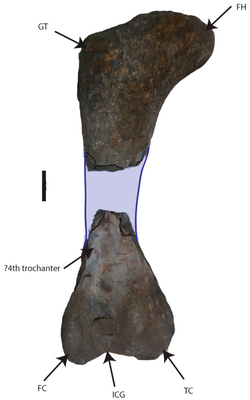Biology:Lapparentosaurus
| Lapparentosaurus | |
|---|---|

| |
| Partial left femur | |
| Scientific classification | |
| Domain: | Eukaryota |
| Kingdom: | Animalia |
| Phylum: | Chordata |
| Clade: | Dinosauria |
| Clade: | Saurischia |
| Clade: | †Sauropodomorpha |
| Clade: | †Sauropoda |
| Clade: | †Gravisauria |
| Clade: | †Eusauropoda |
| Genus: | †Lapparentosaurus Bonaparte, 1986 |
| Species: | †L. madagascariensis
|
| Binomial name | |
| †Lapparentosaurus madagascariensis (Lydekker, 1895)
| |
| Synonyms | |
| |
Lapparentosaurus is a genus of sauropod dinosaur from the Middle Jurassic. Its fossils were found in Madagascar (Isalo III Formation).[1] The type species is L. madagascariensis.
Discovery and naming
In 1895 Richard Lydekker named a new species of Bothriospondylus, B. madagascariensis based on fossils found before 1894 by Joseph Thomas Last in the Majunga Basin in layers of the Bathonian, the Isalo III Formation.[1] Because there was no real connection with this English form, in 1986 José Fernando Bonaparte named a separate genus.[2] The type species, the only known, is Lapparentosaurus madagascariensis. The generic name honours Albert-Félix de Lapparent. The holotype assigned by Bonaparte, MAA 91-92, consists of two neural arches. Much more abundant material has been referred, from at least three but perhaps as much as ten individuals from different growth stages. This includes vertebrae and limb elements but no skulls. The species is still lacking a good description and diagnosis. It should not be confused with ?Bothriospondylus madagascariensis, a distinct taxon now named Vouivria, or another distinct primitive sauropod from the Isalo III Formation once also referred to as "Bothriospondylus" madagascarensis,[3] described as the new genus Narindasaurus in 2020.[4]
Age determination studies performed using growth ring counts suggest that this sauropod took 31–45 years to reach sexual maturity[5] and was relatively fast-growing given the presence of a large amount of fibrolamellar bone.[6]
Classification
The phylogenetic position of Lapparentosaurus was long poorly understood. It exhibits an unusual combination of characters of both basal and derived sauropods.[7] It has been classified as a brachiosaurid or an indeterminate titanosauriform.[7] However, recent phylogenetic analyses have shown it to be a basal eusauropod, not closely related to brachiosaurids at all.[8] After many decades, Emilie Läng in 2008 recovered a traditional Cetiosauridae including Lapparentosaurus.[9] An in-depth revision in 2019 of the genus by Raveloson, Clark & Rasoamiaramana recovered a similar position with Lapparentosaurus being part of a paraphyletic Cetiosauridae, also including a multitude of similar Middle Jurassic cetiosaurids such as Chebsaurus, Ferganasaurus, and Cetiosaurus.[10] This position is supported by the presence of two autapomorphies common on both Lapparentosaurus and Cetiosaurus: a pyramid-shaped neural spine from the anterior dorsal vertebrae with tapering in shape or not flaring distally and loss of the spinodiapophyseal lamina on the dorsal vertebrae.[10]
Gallery
All possible remains of Lapparentosaurus:
References
- ↑ 1.0 1.1 Lydekker, R. (1895). "On bones of a sauropodous dinosaur from Madagascar". Quarterly Journal of the Geological Society of London 51 (1–4): 329–336. doi:10.1144/gsl.jgs.1895.051.01-04.25. https://zenodo.org/record/1448543.
- ↑ Bonaparte, J.F. (1986). "Les dinosaures (Carnosaures, Allosauridés, Sauropodes, Cétosauridés) du Jurassique Moyen de Cerro Cóndor (Chubut, Argentina)". Annales de Paléontologie (Vert.-Invert.) 72 (3): 325–386.
- ↑ Mannion, Philip D. (March 2010). "A revision of the sauropod dinosaur genus ' Bothriospondylus ' with a redescription of the type material of the Middle Jurassic form ' B. madagascariensis '" (in en). Palaeontology 53 (2): 277–296. doi:10.1111/j.1475-4983.2009.00919.x.
- ↑ Rafael Royo-Torres; Alberto Cobos; Pedro Mocho; Luis Alcalá (2020). "Origin and evolution of turiasaur dinosaurs set by means of a new 'rosetta' specimen from Spain". Zoological Journal of the Linnean Society 191: 201–227. doi:10.1093/zoolinnean/zlaa091.
- ↑ de, Ricqlès (1983). "Cyclical growth in the long bones of a sauropod dinosaur". Acta Palaeontologica Polonica 28: 225–232.
- ↑ Rimblot-Baly, F.; de Ricqlès, A.; Zylberberg, L. (1995). "Analyse paléohistologique d'une série de croissance partielle chez Lapparentosaurus madagascariensis (Jurassique Moyen): essai sur la dynamique de croissance d'un dinosaure sauropode". Annales de Paléontologie 81: 49–86.
- ↑ 7.0 7.1 Upchurch, Paul; Barrett, Paul M.; Dodson, Peter (2004). "Sauropoda". in Weishampel, David B.; Dodson, Peter; Osmólska, Halszka. The Dinosauria (2nd ed.). University of California Press. ISBN 0520254082.
- ↑ Royo-Torres, Rafael; Upchurch, Paul; Kirkland, James I.; DeBlieux, Donald D.; Foster, John R.; Cobos, Alberto; Acalá, Luis (2017). "Descendants of the Jurassic turiasaurs from Iberia found refuge in the Early Cretaceous of western USA". Scientific Reports 7 (1): 14311. doi:10.1038/s41598-017-14677-2. PMID 29085006. Bibcode: 2017NatSR...714311R.
- ↑ Läng, E. (2008). Les Cétiosaures (Dinosaura, sauropoda) et les sauropodes du Jurassique moyen: revision systématique, nouvelles découvertes et implications phylogénétiques (Doctoral dissertation, Paris, Muséum national d'histoire naturelle).
- ↑ 10.0 10.1 Raveloson, Miky Lova Tantely; Clark, Neil D. L.; Rasoamiaramana, Armand H. (2019). "New Information on the Madagascan Middle Jurassic Sauropod Lapparentosaurus madagascariensis" (in en). Geosciences 9 (12): 498. doi:10.3390/geosciences9120498. Bibcode: 2019Geosc...9..498R.
Wikidata ☰ Q2154332 entry
 |






